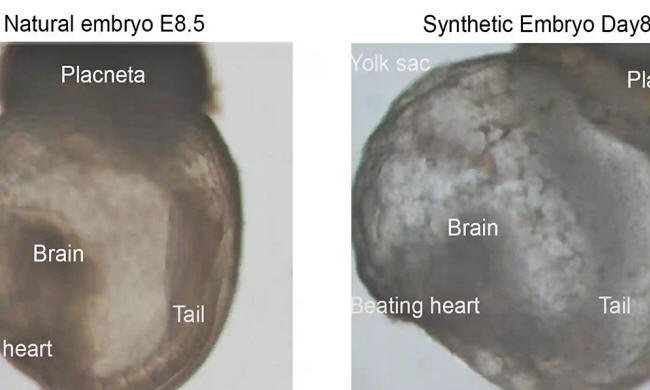|

by Ian Sample
August 03,
2022
from
TheGuardian Website

Photograph:
Weizmann Institute
Forget eggs, sperm, fertilization and sex for
procreation.
This
is straight out of Huxley's 'Brave
New World,' written in 1932 and looking into
the face of Technocracy.
Pregnancy was forbidden as genetically engineered babies
were created in test tubes and "birthed" in incubators.
Forget eggs, sperm and fertilization...
Source
Researchers use stem cells from mice to form embryo-like structures
with intestinal tract, beginnings of a brain, and a beating heart
Researchers have created the world's first "synthetic embryos" in a
groundbreaking feat that bypassed the need for sperm, eggs and
fertilization.
Scientists at the
Weizmann Institute in Israel found that stem cells
from mice could be made to self-assemble into early embryo-like
structures with,
an intestinal tract, the beginnings of a brain, and
a beating heart...
Known as synthetic embryos because they are created without
fertilized eggs, the living structures are expected, in the near
term, to drive deeper understanding of how organs and tissues form
during the development of natural embryos.
But researchers believe the work could also reduce animal
experimentation and ultimately pave the way for new sources of cells
and tissues for human transplantation.
For example, skin cells
from a leukemia patient could potentially be transformed into bone
marrow stem cells to treat their condition.
"Remarkably, we
show that embryonic stem cells generate whole synthetic embryos,
meaning this includes the placenta and yolk sac surrounding the
embryo," said Prof Jacob Hanna, who led the effort.
"We are truly
excited about this work and its implications."
The work (Post-Gastrulation
Synthetic Embryos generated Ex Utero from Mouse Na´ve ESCs) is published
in Cell.
Last year, the same
team described how they had built a mechanical womb that enabled
natural mouse embryos to grow
outside the uterus for several days.
In the latest work,
the same device was used to nurture mouse stem cells for more than a
week, nearly half the gestation time for a mouse.
Some of the cells
were pre-treated with chemicals, which switched on genetic programs
to develop into placenta or yolk sac, while others developed without
intervention into organs and other tissues.
While most of the
stem cells failed to form embryo-like structures, about 0.5%
combined into little balls that grew distinct tissues and organs.
When compared with
natural mouse embryos,
the synthetic embryos were 95% the same in
terms of their internal structure and the genetic profiles of the
cells.
As far as the scientists could tell, the organs that formed
were functional.
Hanna said,
synthetic embryos were not "real" embryos and did not have the
potential to develop into live animals, or at least they hadn't when
they had been transplanted into the wombs of female mice.
He has founded a
company called Renewal
Bio that aims to grow human synthetic embryos to provide tissues
and cells for medical conditions.
"In Israel and
many other countries, such as the US and the UK, it is legal and
we have ethical approval to do this with human-induced
pluripotent stem cells.
This is providing an ethical and
technical alternative to the use of embryos," Hanna said.
Dr James Briscoe,
a principal group leader at the Francis Crick Institute in
London, who was not involved in the research, said it was important
to discuss how best to regulate the work before human synthetic
embryos were developed.
"Synthetic
human embryos are not an immediate prospect.
We know less
about human embryos than mouse embryos and the inefficiency of
the mouse synthetic embryos suggests that translating the
findings to human requires further development," Briscoe said.
But, he added:
"Now is a good
time to consider the best legal and ethical framework to
regulate research and use of human synthetic embryos and to
update the current regulations."
Speaking to
StatNews, Prof Paul Tesar, a geneticist at Case
Western Reserve University, said the more scientists pushed stem
cell-derived embryos further and further along the path of
development, the more the synthetic and natural embryos begin to
merge.
"There will
always be a grey area," he said.
"But as
scientists and as a society we need to come together to decide
where the line is and define what is ethically acceptable."
The creation of
"synthetic" human embryos is outside of the legal framework of the
UK's Human Fertilization and Embryology Act, but it would be
unlawful to use them to establish a pregnancy in a woman, because
they are not classed as "permitted embryos"...
|


